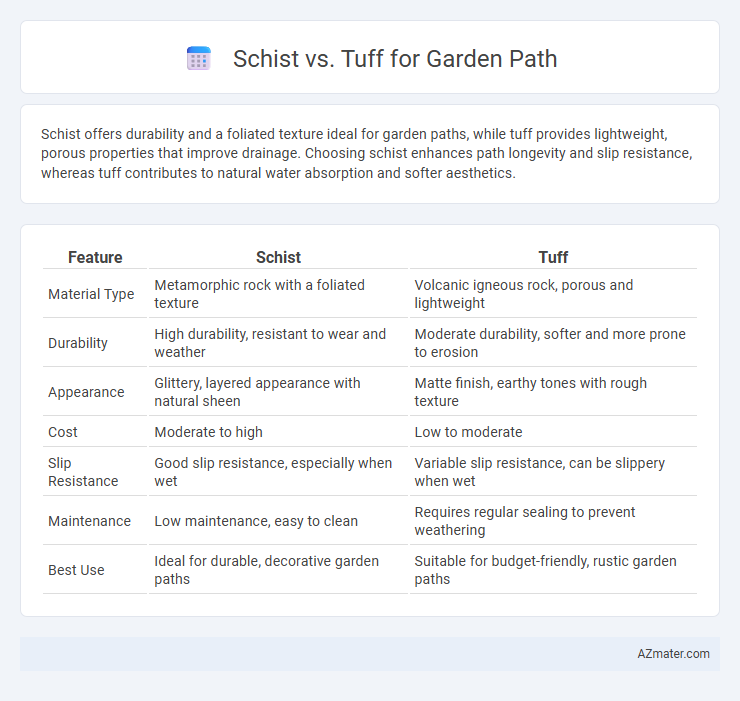Schist offers durability and a foliated texture ideal for garden paths, while tuff provides lightweight, porous properties that improve drainage. Choosing schist enhances path longevity and slip resistance, whereas tuff contributes to natural water absorption and softer aesthetics.
Table of Comparison
| Feature | Schist | Tuff |
|---|---|---|
| Material Type | Metamorphic rock with a foliated texture | Volcanic igneous rock, porous and lightweight |
| Durability | High durability, resistant to wear and weather | Moderate durability, softer and more prone to erosion |
| Appearance | Glittery, layered appearance with natural sheen | Matte finish, earthy tones with rough texture |
| Cost | Moderate to high | Low to moderate |
| Slip Resistance | Good slip resistance, especially when wet | Variable slip resistance, can be slippery when wet |
| Maintenance | Low maintenance, easy to clean | Requires regular sealing to prevent weathering |
| Best Use | Ideal for durable, decorative garden paths | Suitable for budget-friendly, rustic garden paths |
Introduction: Choosing Between Schist and Tuff for Garden Paths
Schist and tuff are both popular materials for garden paths, each offering unique aesthetic and functional qualities. Schist features a layered, glittery texture with excellent durability and natural slip resistance, making it suitable for high-traffic areas. Tuff, a volcanic rock, provides a softer appearance with good porosity and weather resistance, ideal for blending with organic landscaping themes.
Geological Origins: What Are Schist and Tuff?
Schist is a metamorphic rock formed from the intense heat and pressure that recrystallize minerals like mica and quartz into distinctive layers, often resulting in a foliated texture ideal for garden paths due to its durability and aesthetic appeal. Tuff is an igneous rock composed of volcanic ash ejected during explosive eruptions that solidifies into a porous, lightweight material, offering unique coloration and a softer surface for landscaping. Understanding their geological origins helps landscapers choose Schist for strength and texture, while Tuff provides varied hues and lighter composition for garden pathways.
Appearance: Visual Differences Between Schist and Tuff
Schist exhibits a foliated texture with visible layers of mica and mineral grains that create a shiny, glittering appearance, often displaying silver, green, or gray hues. Tuff, formed from volcanic ash, has a porous, rough texture with soft edges and a uniform, muted color palette ranging from light beige to reddish-brown. The distinct visual contrast between the glossy, flaky surface of schist and the coarse, matte finish of tuff makes them uniquely suited for different garden path aesthetics.
Durability and Weather Resistance Comparison
Schist offers superior durability with its dense, foliated structure, making it highly resistant to cracking and erosion in garden paths. Tuff, a volcanic rock with a porous texture, tends to weather more quickly, absorbing moisture that can lead to surface degradation over time. For long-lasting garden paths, schist provides better weather resistance and minimal maintenance compared to the softer, less durable tuff.
Texture and Surface Traction for Safety
Schist offers a coarse, foliated texture that provides excellent surface traction, making it a safer choice for garden paths prone to moisture. Tuff, being a softer, porous volcanic rock, tends to have a smoother surface that can become slippery when wet, reducing its safety for foot traffic. For pathways prioritizing slip resistance and durability, schist's natural roughness enhances grip and minimizes the risk of falls.
Installation Process and Workability
Schist offers a dense, foliated structure that allows precise cutting and easy shaping, making garden path installation more straightforward with stable, interlocking edges. Tuff, being a lightweight, porous volcanic rock, is softer and more brittle, requiring careful handling and specialized tools to avoid crumbling during cutting and placement. The workability of schist enables tighter joints and smoother surfaces, while tuff's irregular texture necessitates additional groundwork for level paths and consistent alignment.
Environmental Impact and Sustainability Considerations
Schist, a metamorphic rock with a foliated texture, offers durability and natural aesthetics for garden paths while having a relatively low environmental impact due to minimal processing requirements. Tuff, a volcanic rock formed from ash deposits, is lightweight and porous, potentially contributing to better water drainage but may require more energy-intensive extraction and processing, impacting its sustainability profile. Choosing between schist and tuff depends on balancing factors such as local availability, carbon footprint of quarrying operations, and long-term landscape resilience.
Cost Comparison: Schist vs Tuff for Garden Paths
Schist typically costs more than tuff per square foot due to its durability and aesthetic appeal, with prices ranging from $15 to $30 compared to tuff's $10 to $20. Installation expenses can also be higher for schist because of its weight and the need for specialized handling. Tuff offers a more budget-friendly option for garden paths without compromising on weather resistance and slip prevention.
Maintenance Needs and Longevity
Schist offers low maintenance needs due to its durability and resistance to weathering, making it ideal for garden paths with heavy foot traffic. Tuff, being a softer volcanic rock, requires more frequent upkeep to prevent erosion and surface wear over time. Schist generally provides greater longevity, maintaining structural integrity and aesthetic appeal longer than tuff in outdoor garden environments.
Design Tips for Using Schist or Tuff in Your Garden Path
Schist offers a rugged, textured surface ideal for garden paths requiring natural durability and slip resistance, while tuff provides a lighter, porous option with warm earth tones that blend seamlessly into rustic or Mediterranean designs. When designing a garden path with schist, aim for irregular shapes and varied sizes to enhance its organic appeal and complement lush greenery. For tuff, focus on smooth, consistent paving patterns that highlight its soft color palette and encourage a serene, sunlit garden atmosphere.

Infographic: Schist vs Tuff for Garden Path
 azmater.com
azmater.com